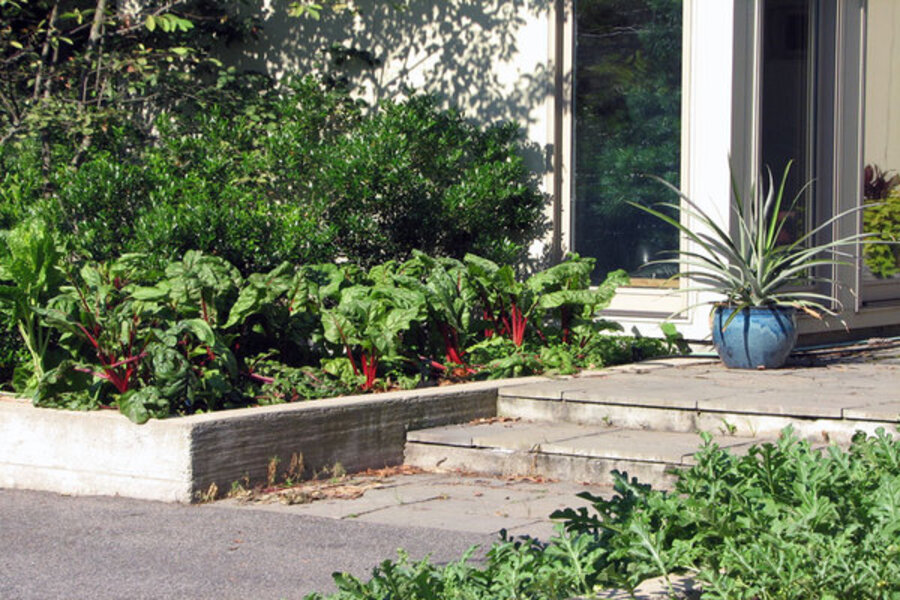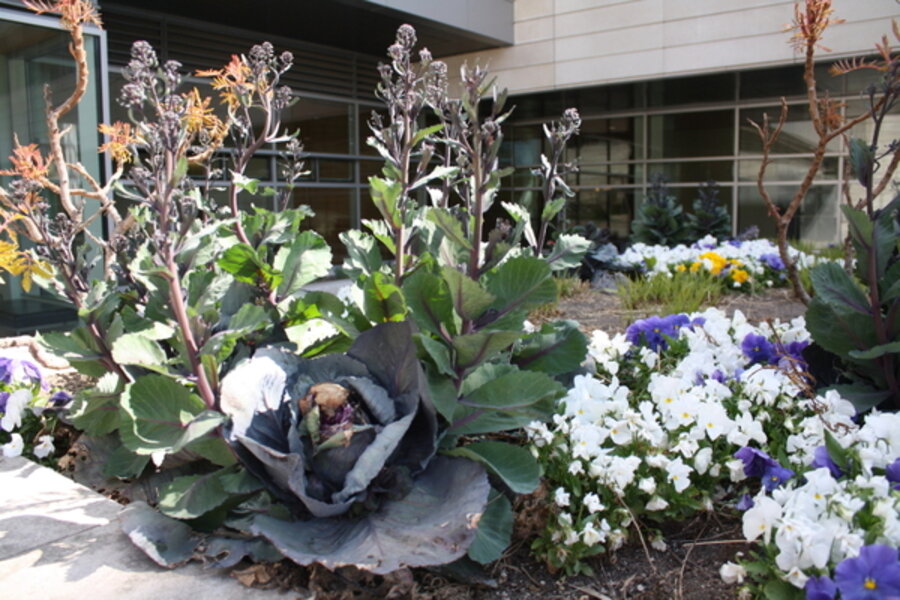In a hungry world, should edible landscaping do more?
A few years ago, edible landscaping — the practice of mixing vegetables and herbs in decorative displays — was a vogue new idea. Now it’s commonplace. You can find attractive staples like Swiss chard, kale, and ornamental chilies growing everywhere, and not just in yards. I see these and other edibles in the parking-lot planters of my local shopping center.
Yet I can’t help but think we are missing an important opportunity to make gardens and gardening more relevant by actually harvesting and eating these landscape crops.
Amid the seemingly endless Great Recession, lots of people are hungry. According to Feeding America, a leading hunger relief charity, one in six American does not have enough to eat. These numbers do not include the many citizens who are not hungry per se but lack access to fresh fruits and vegetables
My point is this: At the end of every growing season, we gardeners need to make sure that our “landscaping” makes its way to the local food bank. If we want to share the joy and value of gardening — and every gardener I know does — what better way to do so than by donating a bag of home-grown produce? (One way is through the Plant a Row for the Hungry program.
Moreover, we gardeners need to encourage more shopping centers, schools districts, and public buildings to both plant and harvest edibles as part of their landscaping.
And if you don’t include edibles in your decorative beds, perhaps it’s time to consider it.
Adopting a both/and perspective
Obviously, not all edible landscaping will work as potential foodstuffs. On my bustling street, the poor plants, edible and otherwise, are gassed by thousands of mufflers every year and probably “watered” by almost as many dogs. No one should have to eat them.
Nor does it make sense to donate veggies grown exposed to heavy doses of lawn chemicals.
Yet much edible landscaping is perfectly good for consumption. For instance, the shopping center I mentioned earlier often plants Bright Lights Swiss chard around a courtyard that functions as a town square. Every time I walk by, I am tempted to collect those gorgeous leaves for the neighborhood soup kitchen.
So far my wife has prevented me, but this winter I am going to get on the property manager’s case about it. It simply does not make sense to let those vegetables go to waste when so many people are hungry.
Here some gardeners will register a protest about the purpose of edible landscaping. It’s just that, they’ll say — landscaping. Its purpose is to beautify.
But this either/or thinking is misleading. There’s no good reason that, with a little care, the same landscaping that beautifies the neighborhood in June can’t be eaten come October. In fact, making our landscaping serve both purposes seems precisely the kind of challenge that gardeners crave.
A sweet case in point
The poster child for this sort of missed opportunity is the ornamental sweet potato. I understanding why people grow them; they bring the perfect “spill” to a planter, and their leaves come in all manner of colors, ranging from bright green to dark purple. There’s one for every palate.
Of course, ornamental sweet potatoes produce inedible tubers. Every time I see them — and they’re everywhere these days—I wonder if the gardener consider maybe, just maybe, planting an edible sweet potato instead.
Some of the edible varieties don’t look that different in their foliage than their ornamental cousins. And as Anne K. Moore and Linda Weiss recently blogged on this page, they’re easy to grow and harvest.
If we replaced just a quarter of all the ornamental sweet potatoes out there with edible ones, think of all the healthy, hearty calories we could grow for our hungry neighbors.
-----
Christopher Weber is a journalist and work-at-home dad in Chicago. He has written about gardening for the Chicago Tribune and taught it at a local school. His current favorite vegetable to grow is Brussels sprouts. You can find more information about him, including articles and blogs, at christopherweber.org. To read more by Christopher at Diggin' It, click here.







